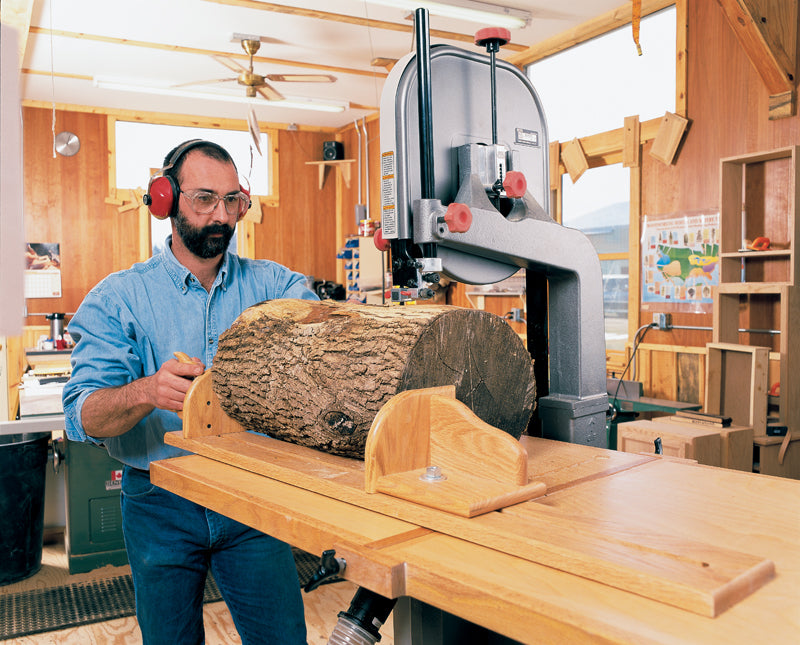Band Saw
Band Saw

A band saw is a powerful tool you'll use to make precise straight or curved cuts in wood, metal, and more. It features a continuous steel blade with sharp teeth that moves on two wheels, letting you tackle everything from furniture and decorative work to metal pipes and sheet cutting. With the right blade and proper safety gear, you'll boost accuracy and creativity in your projects. Stick with us to discover the right type, safety tips, and handy accessories.
Key Takeaways
-
A band saw uses a continuous steel blade with teeth to cut wood, metal, and other materials precisely.
-
It consists of upper and lower wheels, a motor, blade guides, and safety guards for smooth and safe operation.
-
Band saws are available in benchtop, floor-standing, portable, horizontal, and vertical models for various applications.
-
Common uses include woodworking (curved cuts, resawing, joinery) and metalworking (cutting pipes, bars, and sheet metal).
-
Regular maintenance, proper blade tension, and safety practices are essential for efficient and safe band saw operation.
Understanding the Basic Components
A band saw relies on several key components working together to deliver precise cuts.
When you look at band saw anatomy, you’ll notice the continuous blade, which is a steel band with teeth that moves on two wheels. These wheels, usually upper and lower, guide and maintain blade tension. The motor powers the wheels, setting the blade in motion.
You’ll also find blade guides and bearings that keep the blade running straight, ensuring accuracy. The table beneath the blade supports your material and can tilt for angled cuts. An adjustable guard protects your hands and lets you work safely.
Types of Band Saws
When you’re choosing a band saw, you’ll find several main types that suit different tasks and workspaces.
Benchtop band saws are compact and ideal if you have limited space or do smaller projects.
Floor-standing models offer more power and capacity, handling heavier or larger materials with ease.
If you need mobility, portable band saws are lightweight and easy to carry, letting you make precise cuts on job sites or in tight spots.
Horizontal and vertical band saws refer to blade orientation and the type of cuts you can make.
For the most demanding tasks, industrial band saws are designed for continuous, heavy-duty use and can cut through thick materials efficiently.
Key Applications in Woodworking and Metalworking
With so many types of band saws available, it's helpful to know how each fits into real-world tasks.
In woodworking, you'll find band saws essential for making curved cuts, resawing thick boards, and crafting intricate joinery. These machines let you experiment with woodworking techniques like cutting veneers, shaping cabriole legs, and producing smooth, uniform edges.
Whether you're building furniture or decorative items, a band saw offers precise control and versatility.
For metalworking projects, band saws handle cutting pipes, bars, and sheet metal with ease. You can create straight or angled cuts for frames and brackets, or slice through tough alloys for fabrication work.
Their ability to cut a variety of metals makes them valuable in repair shops, fabrication, and custom metalworking tasks.
Choosing the Right Blade for Your Material
Selecting the right blade makes a huge difference in your band saw’s performance and the quality of your cuts. To get the best results, match the blade material to the type of material you’re cutting.
For example, carbon steel blades work well for wood, while bi-metal or carbide-tipped blades handle metal and other tough materials. Pay close attention to tooth configuration as well.
For smoother, finer cuts, use blades with more teeth per inch (TPI). If you’re after faster, rougher cuts, go for fewer TPI and a more aggressive tooth shape.
Always check your material’s thickness and hardness before choosing. With the right blade material and tooth configuration, you’ll make cleaner, safer, and more efficient cuts every time.
Essential Safety Practices
Before you power up your band saw, make safety your top priority. Taking a few extra seconds now can prevent accidents and injuries down the road.
Always use the right personal protective equipment and know what to do if something goes wrong. Here are four essential safety practices you should follow every time:
-
Wear personal protective equipment—always use safety glasses, hearing protection, and avoid loose clothing or jewelry.
-
Check blade guards—make sure all guards are in place and adjusted correctly before starting your band saw.
-
Keep your hands clear—use a push stick or guide when working close to the blade to protect your fingers.
-
Know emergency procedures—familiarize yourself with the location of the emergency stop and first aid kit.
Maintenance and Troubleshooting Tips
Regular maintenance is key to keeping your band saw running smoothly and safely. Start by checking blade tension before each use; a loose blade can slip, while one that’s too tight may snap. Adjust it according to your manufacturer’s guidelines.
Inspect wheel alignment as well—misaligned wheels cause uneven cutting and excessive blade wear. Clean dust and debris from the wheels, guides, and table to prevent buildup that can impact accuracy. Lubricate moving parts as recommended to avoid friction and wear.
If you notice unusual noises, vibration, or wandering cuts, stop and troubleshoot right away. Check for dull or damaged blades and replace them promptly.
Creative Projects You Can Tackle
Once your band saw is tuned up and running smoothly, you’re ready to explore its creative potential. This versatile tool lets you tackle a wide range of projects, from practical to purely artistic.
Imagine transforming raw lumber into eye-catching wooden sculptures or crafting intricate designs that would be tough to achieve with other saws. Whether you’re a seasoned woodworker or just starting out, you’ll find plenty of inspiration.
Here are four creative projects to try:
-
Craft custom puzzle pieces with smooth, curving lines.
-
Create decorative wooden boxes featuring intricate designs.
-
Sculpt animal figurines or abstract wooden sculptures as unique gifts.
-
Cut personalized wooden signs for your home or workshop.
Let your imagination guide you; your band saw offers endless possibilities!
Upgrades and Accessories to Enhance Performance
While your band saw works well out of the box, a few strategic upgrades and accessories can make a dramatic difference in its performance and versatility.
Start by upgrading the blade guides. High-quality blade guides, such as those made from ceramic or ball bearings, offer better blade stability and reduce friction, which leads to cleaner, more accurate cuts.
Next, consider investing in robust fence systems. A reliable fence lets you make straight, repeatable cuts with ease and precision, especially when resawing lumber or ripping boards.
Adding a miter gauge can further improve your ability to make angled cuts. Dust collection attachments help keep your workspace clean and your saw running smoothly.
With these enhancements, you’ll maximize your band saw’s capabilities and achieve more professional results.
Frequently Asked Questions
Can a Band Saw Cut Plastic or Acrylic Materials?
You can cut plastic or acrylic materials if you use the right cutting techniques and consider the material types. Adjust your speed, use a fine-toothed blade, and make certain your setup prevents chipping or melting during the process.
How Much Electricity Does a Typical Band Saw Use?
Imagine your tool’s not guzzling electricity like a wild party guest. With band saw efficiency, you’ll find energy consumption modest—typically 1–2 horsepower motors use about 750–1500 watts, so your electric bill won’t faint in horror.
Are Band Saws Suitable for Beginners?
If you're just starting out, you'll find these machines suitable with the right approach. Focus on beginner tips like starting slow, reading the manual, and always follow safety precautions to guarantee a safe, productive experience.
What Is the Average Lifespan of a Band Saw?
You’ll typically get 10 to 15 years of reliable use with proper band saw maintenance. When you stick to regular upkeep, you boost overall band saw durability, avoid unnecessary repairs, and keep your equipment running smoothly for years.
Can I Use a Band Saw Outdoors?
You can use power tools outdoors, but always prioritize outdoor safety. Make sure you’ve got weather protection, like covering electrical parts. Don’t operate equipment in wet conditions, and store everything indoors after use to prevent damage.
Final Remarks
Remember, a band saw is only as good as the hands guiding it—practice makes perfect. As you engage in projects, keep safety first and maintain your machine regularly to guarantee smooth cutting. Choosing the right blade and accessories lets you release creativity, whether you’re shaping wood or slicing metal. With the right know-how and a bit of patience, you’ll find your band saw is a true workhorse in your workshop. Happy cutting!




